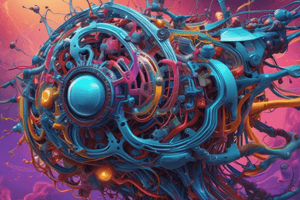Podcast
Questions and Answers
What is the primary function of the machine translation process?
What is the primary function of the machine translation process?
- To provide cultural context to translated texts
- To enhance human translation accuracy
- To convert text from one language to another automatically (correct)
- To generate original content in a different language
Which of the following is NOT a common output of machine translation systems?
Which of the following is NOT a common output of machine translation systems?
- Translated documents
- Text summaries
- Grammar corrections (correct)
- Transliteration of names
In what scenario is machine translation least effective?
In what scenario is machine translation least effective?
- When translating idiomatic phrases (correct)
- For technical documents with clear definitions
- For simple conversational phrases
- When translating between languages with similar syntax
What major limitation do machine translation systems typically have?
What major limitation do machine translation systems typically have?
Which of the following factors can significantly affect the quality of machine translations?
Which of the following factors can significantly affect the quality of machine translations?
Study Notes
Machine Translation Overview
- Machine translation (MT) refers to automated processes that translate text from one language to another using computer programs.
- Google Translate is one of the most widely used machine translation services, employing neural network techniques to improve accuracy and fluency in translations.
Techniques in Machine Translation
- MT systems utilize various methodologies, including statistical machine translation (SMT) and neural machine translation (NMT).
- NMT has become prevalent due to its ability to consider entire sentences rather than word-by-word, enhancing contextual understanding.
Limitations of Machine Translation
- While MT can handle basic translations, it often struggles with idiomatic expressions, cultural references, and context-specific meanings.
- Translations may also lack human-like fluidity and may incorporate errors that require post-editing for professional use.
Applications of Machine Translation
- MT serves in multiple domains, including business communications, online content translation, and multilingual support services.
- It aids language learners by providing instant translations and context for vocabulary usage.
Future of Machine Translation
- Advancements in artificial intelligence and machine learning continue to improve the effectiveness of MT systems.
- Ongoing research aims to enhance linguistic nuances and user customization for translations tailored to specific audiences.
Studying That Suits You
Use AI to generate personalized quizzes and flashcards to suit your learning preferences.
Related Documents
Description
This quiz explores the fundamentals of machine translation (MT), including its methodologies like statistical and neural machine translation. It discusses the applications of MT, its limitations, and the technologies that underpin services like Google Translate. Test your knowledge on how MT impacts communication across languages.




